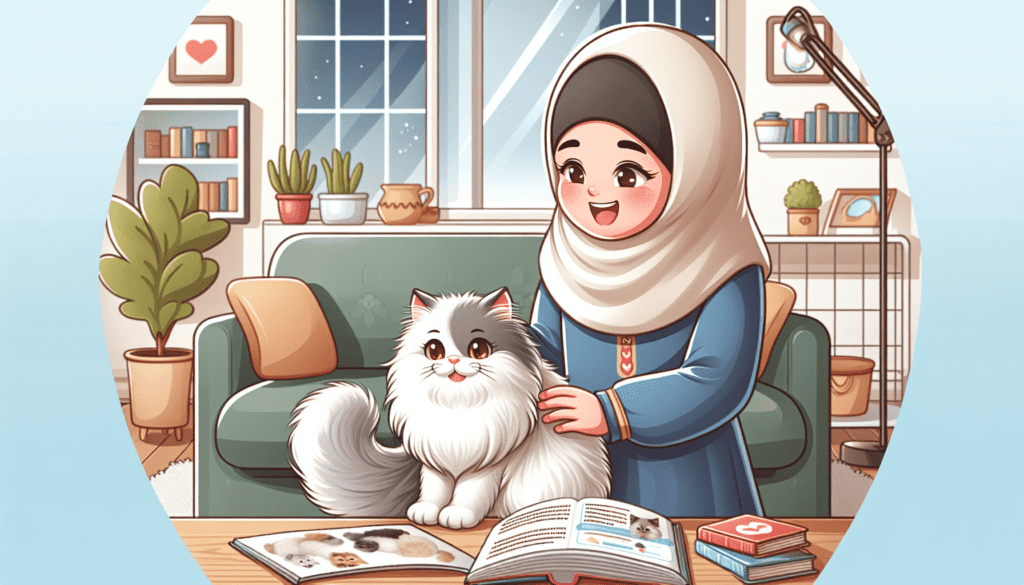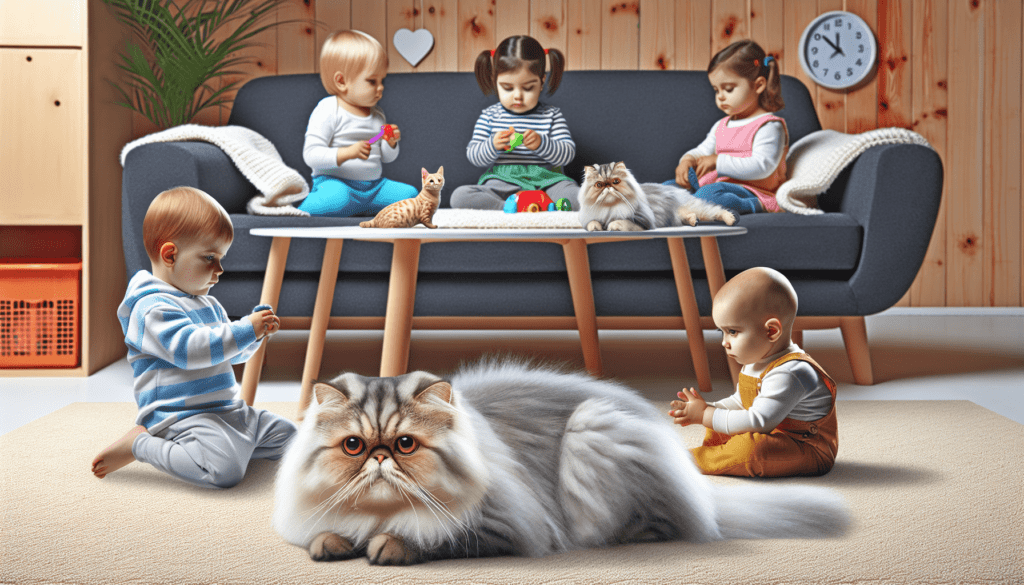Persian cats are renowned for their stunning beauty and luxurious coats, but have you ever wondered if they make good companions for children? With their calm and gentle nature, Persian cats can be a wonderful addition to a family with kids. These feline friends often show great patience and tolerance towards children, making them an ideal choice for families looking for a pet that is both elegant and friendly. So, if you’re considering adding a furry friend to your household and want a companion that is not only visually captivating but also great with little ones, a Persian cat might just be the perfect fit for your family.
Persian Cats and Kids
Persian cats are known for their luxurious fur, distinctive round face, and calm demeanor, making them a popular choice for families with children. Their physical characteristics and temperament make them a great companion for kids, providing numerous benefits. However, there are important considerations to keep in mind when bringing a Persian cat into a household with kids. This article will explore the physical characteristics and temperament of Persian cats, the benefits they offer to children, considerations for kids and Persian cats, tips for introducing them to each other, and advice on raising them together.
Physical Characteristics of Persian Cats
One of the most striking features of Persian cats is their long and beautiful coat. They have soft, thick fur that requires regular grooming to prevent tangles and mats. This grooming process can be an enjoyable activity that kids can participate in, fostering a sense of responsibility and bonding between the cat and the child. Additionally, Persian cats have a round head with large round eyes, a short nose, and a small, compact body. These physical characteristics contribute to their charming and endearing appearance, which often captivates children and nurtures their love for these majestic felines.


Temperament of Persian Cats
Persian cats have a reputation for being calm and gentle, which makes them an ideal companion for kids. They tend to be laid-back and enjoy a relaxed lifestyle, appreciating the comforts of home. Their peaceful nature creates a calming presence, which can have a positive effect on children, particularly those who may be anxious or hyperactive. Persian cats are affectionate and enjoy being cuddled, providing emotional support to kids and helping them feel loved and secure. Their sweet disposition makes it easy for children to form a strong bond with them, nurturing empathy and compassion.
Benefits of Persian Cats for Kids
Calming Presence
One of the major advantages of Persian cats for kids is their calming presence. Children often find solace and comfort in the company of animals, and Persian cats, with their serene and tranquil nature, can help create a peaceful environment. The soothing effect of these felines can be especially beneficial for children dealing with stress, anxiety, or emotional challenges.
Low Activity Level
Persian cats are not particularly active or demanding in terms of exercise. They prefer a more relaxed lifestyle, enjoying quiet moments and lounging around. This low activity level makes them a great choice for families with young children who may not have the energy or time to engage in high-energy play sessions. Kids can still interact with the cat through gentle petting and cuddling, providing them with a sense of companionship without the need for constant physical activity.
Playfulness
While Persian cats may not be as energetic as some other cat breeds, they still have playful tendencies. They enjoy chasing toys, playing hide-and-seek, and engaging in interactive games with their human companions. This playful nature can bring joy and entertainment to children, creating fun and memorable experiences. It also encourages creativity and imagination, as kids come up with new ways to engage their feline friend in play.
Intellectual Stimulation
Interacting with a Persian cat can offer intellectual stimulation for kids. They can learn about the cat’s behavior, body language, and needs, fostering their observation and communication skills. Additionally, caring for the cat’s basic needs, such as providing food, water, and a clean litter box, teaches responsibility and empathy. These small tasks can empower children and help them develop a sense of pride and accomplishment.


Considerations for Kids and Persian Cats
Allergies
Before bringing a Persian cat into a household with children, it is important to consider the possibility of allergies. Some kids may be allergic to cat dander, which can cause symptoms such as sneezing, itching, and difficulty breathing. If a child has a known allergy or a family history of allergies, it is essential to consult with a healthcare professional and possibly undergo allergy testing before committing to a Persian cat.
Grooming and Maintenance
Persian cats require regular grooming to maintain the health and appearance of their coat. This grooming routine usually involves daily brushing to prevent matting and occasional baths to keep their fur clean. Kids can participate in this grooming process under adult supervision, learning how to care for the cat’s coat and establishing a sense of responsibility. However, it is important to ensure that children understand the proper handling techniques and the need for gentleness during grooming sessions.
Supervision
Supervision is crucial when kids and Persian cats interact, especially with younger children who may not fully understand how to handle a cat appropriately. Adults should always be present during interactions to ensure the safety of both the child and the cat. Demonstrating gentle petting techniques and teaching children to respect the cat’s boundaries helps establish a positive and safe relationship between the two.
Respect and Boundaries
Teaching kids respect and boundaries when it comes to Persian cats is essential. They need to understand that cats have their own preferences and may not always be in the mood for play or cuddling. Encouraging children to respect the cat’s personal space and allowing the cat to initiate interactions helps create a harmonious atmosphere. Kids should also be taught to refrain from pulling the cat’s tail or ears, as this can cause fear or aggression and harm to both parties involved.
Introducing Persian Cats to Kids
Slow and Gentle Approach
When introducing a Persian cat to kids, it is crucial to take a slow and gentle approach. Cats, especially those who are not accustomed to young children, may feel overwhelmed or scared initially. Allow the cat to approach the children at their own pace and do not force interactions. Creating a calm and peaceful environment can help the cat feel more at ease and increase the chances of a positive introduction.
Supervised Interactions
During the initial stages of introducing kids to a Persian cat, it is necessary to closely supervise their interactions. This ensures the safety of both parties and enables adults to intervene if necessary. By observing the cat’s body language and reactions to the child’s presence, adults can gauge whether the cat is comfortable or stressed. Adjusting the duration and intensity of interactions based on these cues helps create a positive experience for both the cat and the child.
Encouraging Mutual Respect
As kids and Persian cats spend more time together, it is important to foster mutual respect and understanding. Encourage children to treat the cat gently, using soft voices and gentle movements. Teach them to recognize signs of discomfort or agitation in the cat and to respond appropriately by giving the cat space. Likewise, guide the cat to respond positively to the child’s presence, rewarding calm behavior and allowing the cat to set boundaries when needed.
Tips for Raising Persian Cats and Kids Together
Establishing a Routine
Routines are beneficial for both kids and Persian cats. Establishing a consistent daily schedule helps the cat feel secure and allows children to understand the cat’s needs better. Fixing regular meal times, play sessions, grooming sessions, and quiet time helps create a harmonious atmosphere and ensures that both the cat and the child receive the attention and care they require.
Teaching Responsibility
Caring for a Persian cat can be an excellent way to teach kids about responsibility. Assigning age-appropriate tasks, such as feeding the cat, cleaning the litter box, and brushing the fur, instills a sense of responsibility and ownership. Kids can also learn about the importance of regular veterinary care and attending to the cat’s overall well-being. This educational experience strengthens their character development and prepares them for future responsibilities.
Keeping a Clean Environment
Maintaining a clean environment is crucial for the health and well-being of both kids and Persian cats. Regularly cleaning the litter box, vacuuming to remove any loose cat hair, and keeping common areas free of clutter and hazardous objects ensures a safe and hygienic space for everyone. Involving children in these cleaning tasks not only teaches cleanliness but also encourages a sense of cooperation and respect for the shared living space.
In conclusion, Persian cats can be an excellent choice for families with kids. Their physical characteristics and calm temperament make them a great companion, providing numerous benefits for children. By considering the allergies, grooming and maintenance needs, supervision, and teaching respect and boundaries, a harmonious relationship can be established between kids and Persian cats. With a slow and gentle approach, supervised interactions, and encouragement of mutual respect, the bond between children and Persian cats can thrive. By establishing a routine, teaching responsibility, and maintaining a clean environment, the relationship can be further strengthened and contribute to the overall well-being of both the children and the cat. Persian cats not only bring joy and companionship but also provide valuable life lessons and emotional support to children, nurturing their growth and development.

